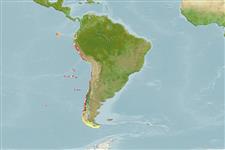Issue
Probably a junior synonym of Tetronarce tremens according to Carvalho et al., 2002 in Weigmann, 2016 (Ref. 106604).
Environment: milieu / climate zone / depth range / distribution range
Ecología
marino demersal; rango de profundidad 175 - 210 m (Ref. 58018). Subtropical
Southeast Pacific: Chile.
Tamaño / Peso / Age
Maturity: Lm ? range ? - ? cm
Max length : 44.5 cm TL macho / no sexado; (Ref. 106604)
Ovoviviparous (Ref. 50449).
Life cycle and mating behavior
Maturities | Reproducción | Spawnings | Egg(s) | Fecundities | Larva
Exhibit ovoviparity (aplacental viviparity), with embryos feeding initially on yolk, then receiving additional nourishment from the mother by indirect absorption of uterine fluid enriched with mucus, fat or protein through specialised structures (Ref. 50449).
Pequeño, G., 1997. Peces de Chile. Lista sistemática revisada y comentada: addendum. Rev. Biol. Mar. Oceanogr. 32(2):77-94. (Ref. 27540)
IUCN Red List Status (Ref. 130435)
Threat to humans
Harmless
Human uses
Herramientas
Special reports
Download XML
Fuentes de Internet
Estimates based on models
Preferred temperature (Ref.
123201): 6.7 - 14.4, mean 11 °C (based on 59 cells).
Phylogenetic diversity index (Ref.
82804): PD
50 = 0.5001 [Uniqueness, from 0.5 = low to 2.0 = high].
Bayesian length-weight: a=0.01479 (0.00659 - 0.03318), b=2.97 (2.78 - 3.16), in cm total length, based on LWR estimates for this (Sub)family-body shape (Ref.
93245).
Nivel trófico (Ref.
69278): 4.0 ±0.6 se; based on size and trophs of closest relatives
Resiliencia (Ref.
120179): Bajo, población duplicada en un tiempo mínimo de 4.5-14 años (Preliminary K or Fecundity.).
Fishing Vulnerability (Ref.
59153): Low to moderate vulnerability (35 of 100).
